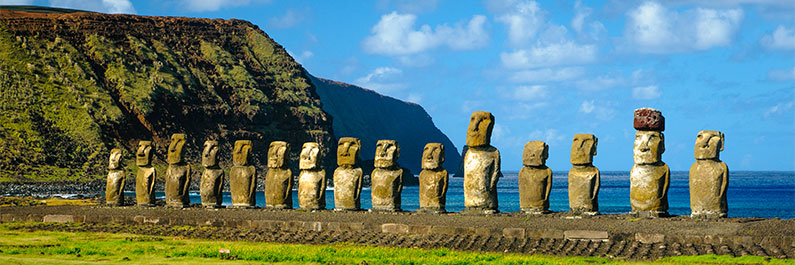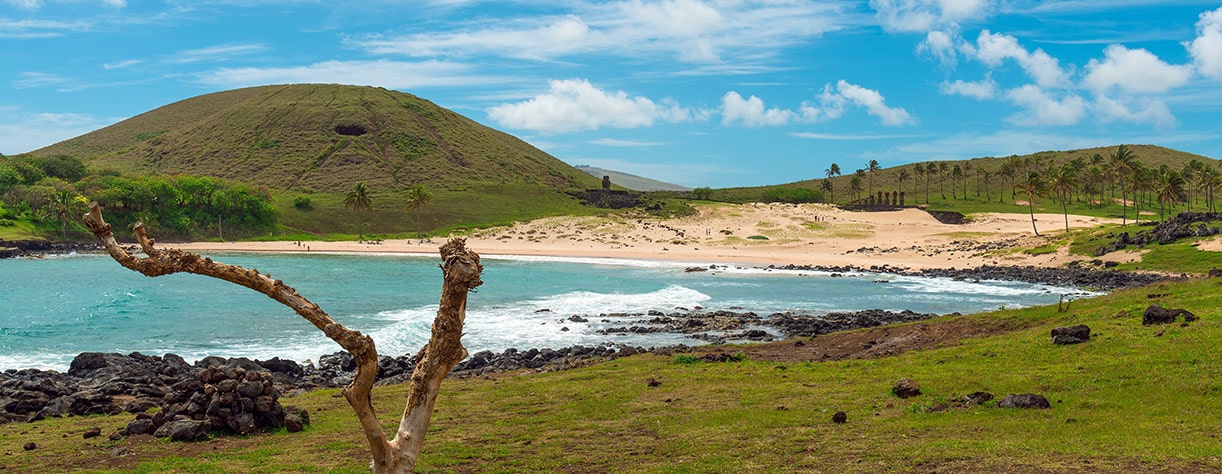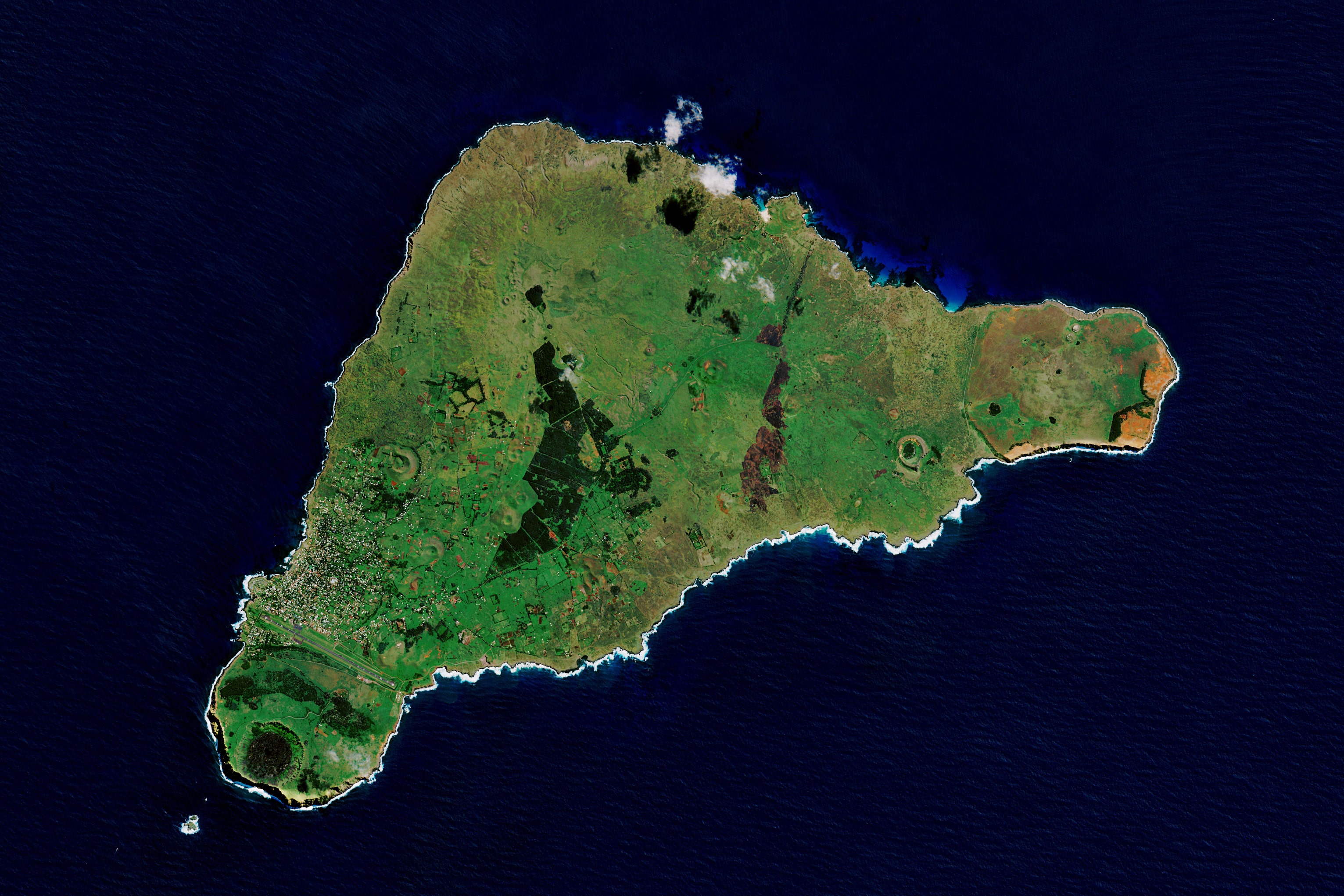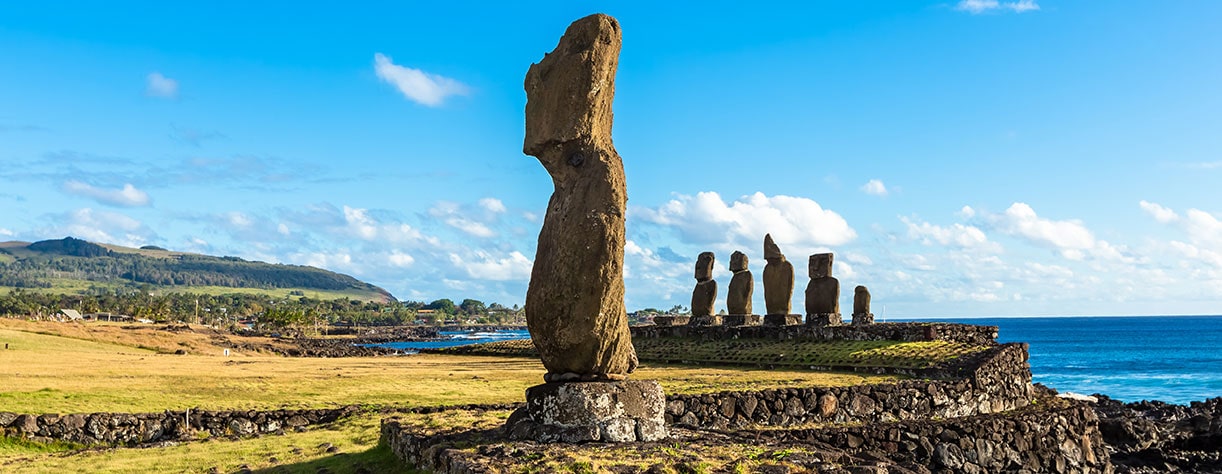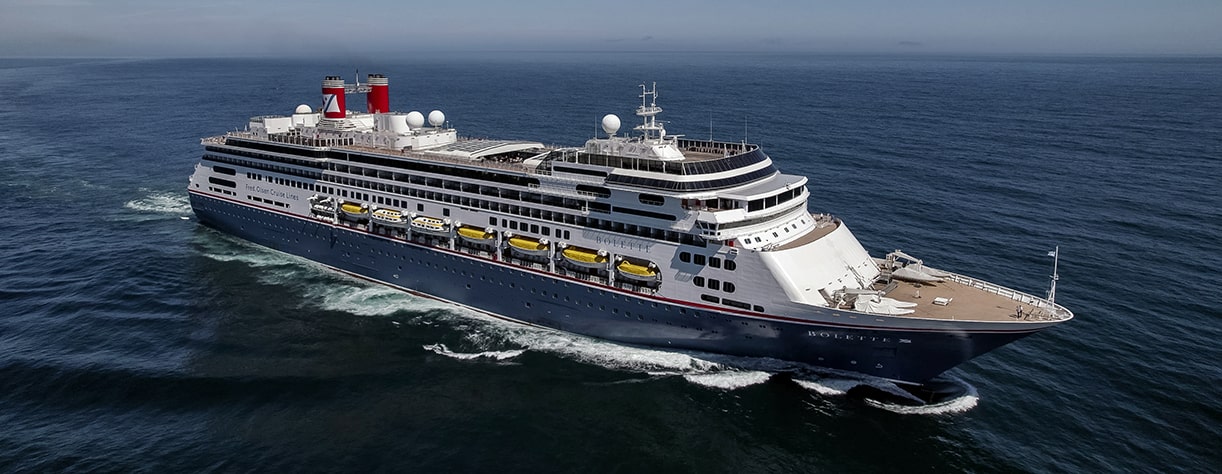The Easter Island heads have captured the imagination of thousands of visitors due to their unique history and character. Now known by its indigenous name, Rapa Nui, this small island’s striking volcanic landscape, cultural importance and remote beauty are the reasons why people continue to sail there.
So if you’re thinking of travelling to Rapa Nui with Fred. Olsen, this article will explain everything you need to know about this special destination.
Where is Easter Island?
Easter Island’s location is around 2,300 miles from Chile’s west coast and 2,500 miles east of Tahiti. The world’s most remote inhabited island, Rapa Nui was formed by a succession of volcanic eruptions and is more than 1,000 miles away from other East Polynesian islands.
Which ocean is Easter Island in?
Easter Island is in the southeastern Pacific Ocean. Though there’s no harbour on Rapa Nui, visiting ships anchor on the west coast of the island. This gives them access to the main habitation, the village of Hanga Roa
How big is Easter Island?
Easter Island is only 14 miles long and seven miles wide. This means it’s about the same size as Jersey in the Channel Islands. Rapa Nui is triangular in shape and has about 63 square miles of rugged landscape made up of hills, caves and volcanic rocks.
Who owns Easter Island?
Easter Island has been a part of Chile since 1888. The annexation of Rapa Nui led to much of the land being used to graze sheep before the inhabitants were granted citizenship and the island was given ‘special territory’ status in 2007. It’s now part of the Chilean Valparaiso region.
Why is Easter Island called Easter Island?
Easter Island was so-called by the first European person to land there, Jacob Roggeveen. The Dutch explorer first spotted the island on Easter Sunday 1722, hence he gave the island its most well-known name (Paaseiland in Dutch).
Most recently, the island has become known as Rapa Nui because this is the preferred Polynesian name chosen by its inhabitants (who also have the same name). The island’s Spanish name is Isla de Pascua, with those living there called pascuense.
However, Thomas Barthel, a German ethnologist and epigrapher who studied the island, noted in 1974 that, according to its oral tradition, its original name was Te Pito O Te Henua, meaning the ‘Navel of the World’.
Facts about Easter Island
- When Admiral Roggeveen landed on Rapa Nui, the land was basically barren. It’s thought that a combination of the settler’s agricultural activities and the arrival of Polynesian rats led to the decimation of palm trees which previously covered the island.
- This area was restored during the 1960s and 1970s by American archaeologist William Mulloy, who was originally a member of Thor Heyerdahl’s 1955 Norwegian Archaeological Expedition.
- The largest volcano on Rapa Nui is 1,665ft (around 510m) above sea level and is called Ramp Kao. Its highest point is known as Mount Terevaka.
- Rapa Nui was designated as a UNESCO World Heritage site in 1995 thanks to its unique cultural significance.
- Today, there’s a mixed population of around 7,000 people living on Rapa Nui, with most having some form of Polynesian ancestry.
Do Easter Island heads have bodies?
Out of the nearly 1,000 statues on Easter Island, at least the majority have bodies, though they are buried underground. Commonly named the ‘Easter Island heads’ because of their appearance, these 887 statues are thought to have been carved out of the island’s volcanic rock (also known as tuff) in the middle period of Rapa Nui’s history (around 1050 to 1680 AD).
It’s not exactly known why these statues were created in such numbers, though they are now thought to be physical images of ancestral chiefs who descended from the gods. Constructing these statues was a way of benefiting from their caring powers and ensuring they watch over the community - hence many face inland. This would account for the individuality of the statues, which still captures the attention of visitors today.
How these statues were placed across the island, including having their bodies buried underground is also one of their biggest mysteries. Weighing on average around 13 tonnes with heights of around 13 feet (four metres), the majority are thought to have been carved in Rano Raraku quarry. This is an extinct volcanic crater where around 400 statues in different stages of completion can now be found.
The ceremonial stages on which moais are placed are called ‘ahus’. The oldest can be found in the Tahai ceremonial complex, which has three ahus pointing north to south. The single maoi which stands there, Ahu Tahai is believed to have been built around 690 AD and is the oldest statue on the island.
In the same complex is Ahu Ko Te Riku, the only moai on the island that’s been restored with original white and red eyes. This moai also has a pukao (topknot or hat) on its head, a feature which can be seen on a few statues across the island. These were constructed and added later by the original peoples and are thoughts to represent the power of that particular person.
Finally, the Tahai complex is home to Ahu Vai Ure, a single ahu with five stone statues of differing sizes standing in a row with their backs towards the sea. As the complex is one of the best places to watch the sun fall below the Pacific Ocean (the name Tahai means ‘where the sun sets’) these statues often catch the last of the light, making this an ideal place to end a day's visit to Rapa Nui.
How to get to Easter Island
To get to Easter Island, visitors will have to take either a flight to the island’s airport or travel there by ship. If you want to experience the drama of the island the way Polynesian settlers or European explorers did hundreds of years ago, then the best way to get to Rapa Nui is by cruise ship.
With Rapa Nui on the itinerary of Fred. Olsen’s Round the World cruises, your first glimpse of the island will be of the statues’ heads peering over the horizon. Once anchored near Hanga Roa, you’ll be able to explore the island’s unique landscape and archaeological sites. Wander through ancient history, find out about the settler’s culture and watch the sunset over the Pacific. Soak up the mystery and beauty of Rapa Nui on a once-in-a-lifetime trip with Fred. Olsen Cruise Lines.


